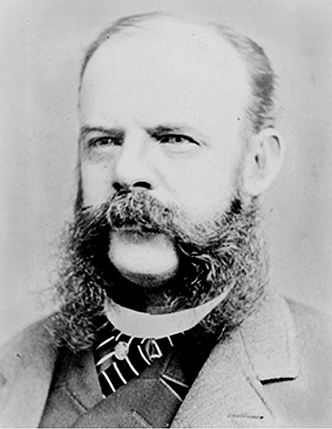Chapter Seven
Edwin Forbes
Edwin Forbes many years after his Gettysburg experience
Had it not been for his enterprising nature, dogged determination, and a good deal of luck, Edwin Forbes, a “Special” for Frank Leslie’s Illustrated Newspaper, might have missed being at the Battle of Gettysburg. Even so, it was a near thing.
A week before the battle, Forbes had been traveling with The Army of the Potomac when Alfred Pleasonton’s¹ Union cavalry had attempted to force its way into the Shenandoah Valley through Ashby’s Gap in the Blue Ridge mountains. A couple of squadrons of J.E.B. Stuart’s² troopers guarding the pass had managed to fended them off. With this repulse, Forbes assumed that operations in the theatre had concluded and it would be an opportune time for him to obtain needed supplies.
Leaving his horse and the army behind, he headed for Washington and the rare luxury of a hotel’s lodging. Arriving in the capital, Forbes was disturbed to learn that Lee’s army was already marching through Maryland and Pennsylvania, and that the Union army was endeavoring to catch up with it.
Fearing that he’d miss the major engagement that was certain to erupt when the armies collided, Forbes boarded a train for Frederick, Maryland. From there, he’d hoped to hitch a ride with the army, but found it had long since departed and that the only train still operating was headed for Baltimore forty miles east. Reluctantly, he opted to backtrack, but it cost him precious time. In Baltimore, he was able to wangle his way onto a supply train headed for Westminster, Maryland, located eighteen miles south of Gettysburg.
While in Westminster, he enjoyed breakfast at a hotel and heard accounts of the first day’s fighting. Attempts to hire a wagon-team failed, and he was forced to rely on “shank’s mare.” In the company of several officers traveling back to their regiments, Forbes walked the rest of the way.
Worn to a nub by the oppressive heat and humidity of his lengthy hike, Forbes belatedly arrived on the battlefield in the early evening of the second day’s battle. Fighting could still be seen and heard, but Forbes was more interested in locating his horse and having some hardtack and coffee while being updated on the first two days of action.
The fighting on Cemetery and Culp’s Hill on the northeastern end of the battlefield continued well into the night, but in a memoir Forbes wrote after the war describing his Gettysburg adventure, he mistakenly claimed that all fighting ceased for the day after Little Round Top was secured shortly after his arrival.
When compared to Alfred Waud’s sophisticated, frequently astounding, illustrations, Edwin Forbes treatments appear amateurish, even primitive. Several factors combined to create this disparity. In later years Forbes claimed he’d studied with a New York artist, but the crudeness of his style suggests he didn’t profit from these lessons, and there’s a good chance he was actually self-taught. Eleven years younger³ than his more accomplished compatriot, Forbes had never worked as an illustrator or reporter before being hired as a “special” by Leslie’s in the summer of 1862. Forbes was endeavoring to learn his craft “on the fly” when Waud had more than a year of war coverage under his belt.
Before going into the field, Forbes had naively assumed he’d be able to find a convenient location on a nearby hill where he could observe the unfolding action, and “sketch exciting incidents at my leisure.” The fallacy of his assumption was dramatically driven home during Forbes’ initial exposure to combat. As he trudged toward the rattle of gunfire, Forbes was unnerved by the sight of wounded soldiers being carried to the rear. Shortly after he’d taken a position on a ridge providing the best view of the action, he was driven from his perch by Confederate artillery fire that raked the area.
After this incident, Forbes interest in depicting combat appears to have diminished, and the majority of his work is concerned with tranquil camp scenes depicting the life of the common soldier. These images failed to excite his editors, and very few of them were reproduced. “Specials” were generally only paid for drawings that ran in the paper. The limited amount of income his work was generating may have been an issue when Forbes abruptly departed Leslie’s in late 1864 and never worked in the industry again.
His first Gettysburg sketch was drawn at 10 a.m. on July 3rd. It’s a panoramic scene encompassing the rear areas east of Little Round Top. In the extreme distance puffs of smoke rise above Culp’s Hill where a desperate fight was being waged, but there’s little in his drawing to suggest this except for written “call outs” which he relied on heavily in his illustrations. Ironically, Forbes elected to remain in the relative safety of this area rather than put himself at risk witnessing Pickett’s climactic afternoon assault on July 3rd, though after the war he vociferously argued otherwise.
1 Major General Alfred Pleasonton, commanding Cavalry Corps, Army of the Potomac
2 Major General James Ewell Brown “Jeb” Stuart, commanding Stuart’s Cavalry Division,Army of Northern Virginia
3 Forbes was 24 and Waud 35 at the time of the Gettysburg campaign.
